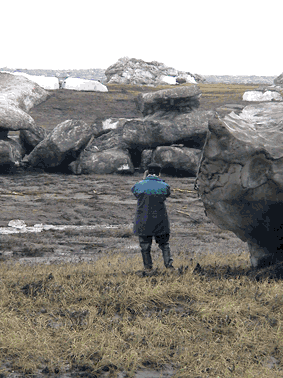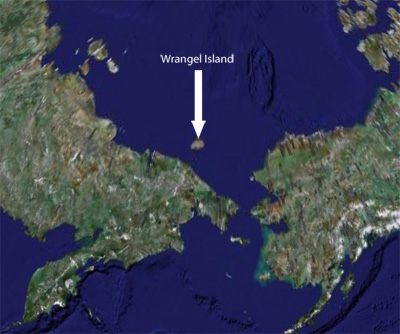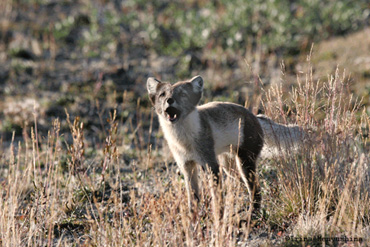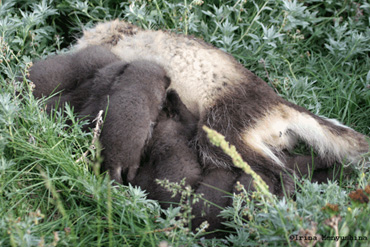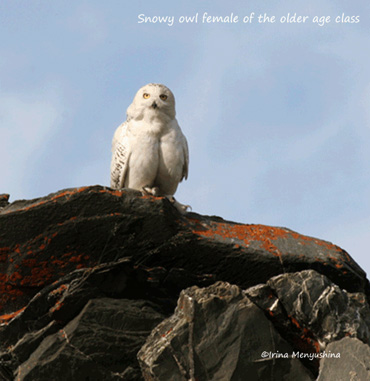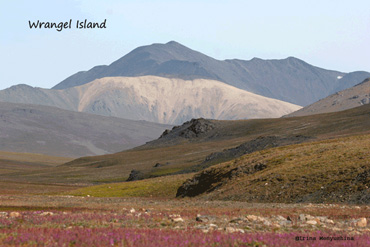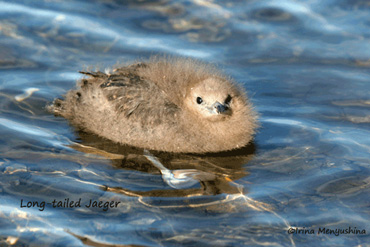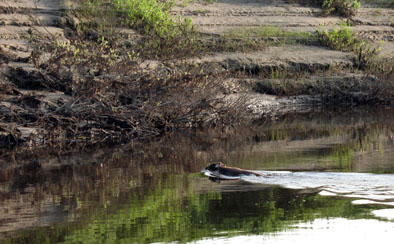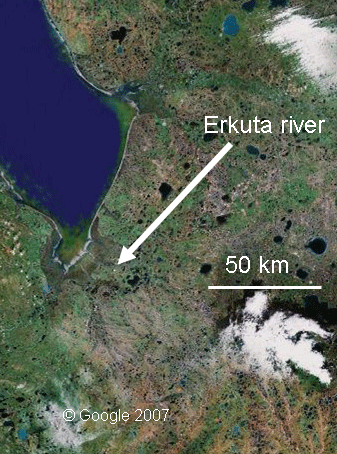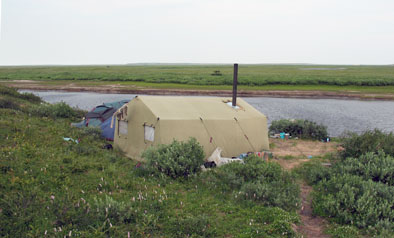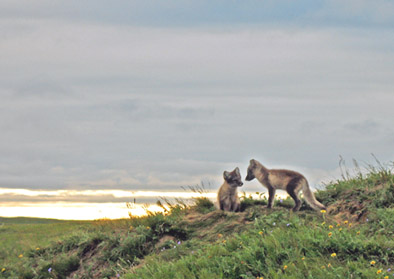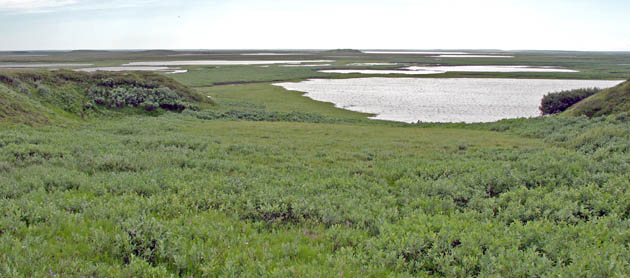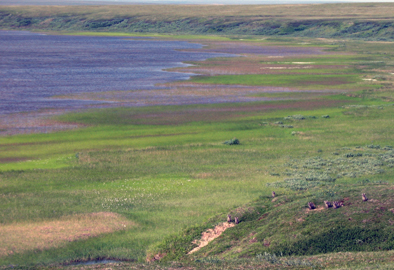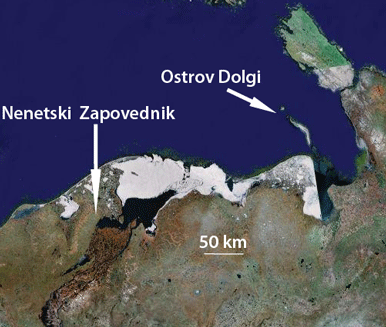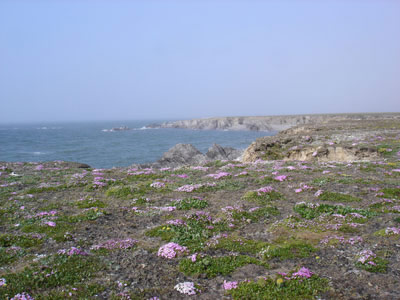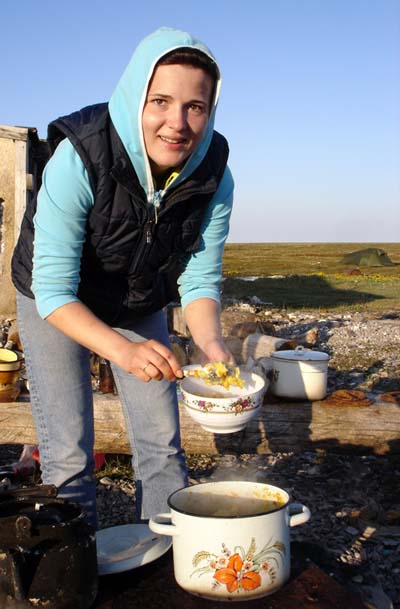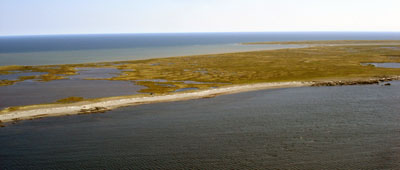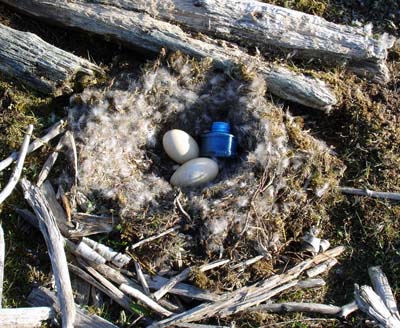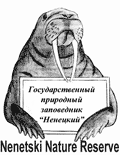
An International Polar Year initiative to use predators as indicators of arctic changes
| |
| Home |
| Project Structure |
| The team |
| Field sites |
| Publications |
| Isotopes |
| News |
| Workshops |
NEWS AND ANNOUNCEMENTS
|
|
Spring and summer 2007 in the Lena Delta
In 2007, spring in the Lena Delta was unusually early and warm. The average temperature in May was -2.4°C, which is 4.4°C above the long-term average. From the 11th to 16th of May the daily average temperatures were above 0°C, which is very unusual for this time of the year. On the 14th of May the average daily temperature was 5.3°C. As a result the average temperature for the second decade of May was +0.4°C. Such warm weather in early May has not been recorded in the Lena Delta during the period for which data are available (since 1976). There were two additional warm periods towards the end of the month (24-25 and 29-31 of May) with temperatures reaching up to 3.4°C. As a result, all snow on the tundra had melted by the end of May. In contrast to the warm weather in May, the beginning of June was cold and the average temperature in the first decade of June was 1.1°C below the long-term average. Snow fell on the 8-9th of June and fully covered the tundra. The temperature definitively raised above 0°C only on the 10th of June, four days later than on average. The second half of June, on the contrary, was clearly warmer than average (4.9°C above the long-term average). The mean daily temperature reached +17.6°C on the 22nd of June. As a result, despite the cold period in the beginning of June, on average the temperature in June was 2.4°C above the long-term average. As a consequence of the early and warm spring, the ice broke up between four and seven days earlier than average in all parts of the Delta. The breaking up of the ice was very fast and the water rose to medium spring levels. In the south-eastern most arm of the Lena, Bykovskaya, the ice broke up between the 5th and 9th of June. The estuaries of the river arms in the north eastern part of the Delta were free of ice on the 14th of June. As in 2006, lemming densities were very low in the Lena Delta this year. While walking over the islands looking for bird nests, we did not see a single lemming. The density of winter nests was also very low. In total we saw about ten winter nests during the whole season. They were found in places where thick layers of snow had been accumulated by wind. In 420 trap nights (26 of June to 16 of July) we caught only a single lemming. In the mainland tundra and the mountain tundra which are south of the Delta, there were high densities of voles. 17 voles were caught between the 28 and 31 of July (162 trap nights).
Arctic foxes were not breeding in the Lena Delta in 2007, and their densities were very low. During the winter, cases of starvation were observed. Despite low densities, arctic fox predation had a considerable impact on birds breeding on the larger islands. Stoats (Mustela eminea) were observed on a few occasions, but only in the mainland tundra in the southern and south eastern parts of the Delta. There were very low numbers raptors preying on small rodents. Pomarine skuas (Stercorarius pomarinus) were numerous during spring migration, but after the 10th of June only single, non-breeeding individuals were observed. Arctic skuas (Stercorarius parasiticus) were less numerous than in previous years and were not breeding on our study plots. However, it is possible that a few of them were breeding in other parts of the Delta. The only skuas we observed breeding were long-tailed skuas (Sercorarius longicaudus) in the mainland tundra to the south and southeast of the Delta. They were not breeding on the islands of the Delta. No snowy owls (Nyctea scandiaca) were observed during the summer. The only observation of a snowy owl was a vagrant individual seen on the 16th of June in the mainland tundra in the south-eastern part of the Delta. Rough-legged buzzards were breeding at densities usual for years with low lemming numbers. Their nests were observed in the southern part of the Delta on the rocky slopes of the Primorskiy Kryazh and Tuora-Sis ridge which face the river, and on the elevated shores of the relict islands of the Primorskiy plain.
This warm summer was favourable for breeding birds. They arrived to the breeding grounds earlier than usual. Most wetland species were present in the Delta in the end of May. On the 21st of June we observed a vagrant sandhill crane (Grus canadensis) in the north-eastern most part of the Delta. In the beginning of the season, high numbers of wetland birds were registered on our line transects. Brent geese (Branta bernicla), king eiders (Somateria spectabilis), sabine’s gulls (Xema sabini) and ross’s gulls (Rhodostethia rosea) were breeding in higher numbers than in previous years. In part this was possible because of low predation pressure by pomarine skuas, which left the Delta early. However, breeding was first of all successful for birds nesting in colonies on small islands which were not accessible for arctic foxes. The breeding success of brent geese was 84.1%. Breeding success was high as well for other species nesting in the brent geese colonies, and only a few single nests were predated. On the larger islands the picture was the opposite. Breeding success for steller’s eiders (Polysticata stelleri) in their typical habitat (polygonal tundra marshes) was 0. All nests we found were either already predated, or were predated later. Most nests of king’s eiders, willow ptarmigans (Lagopus lagopus) and white-fronted geese (Anser albifrons) found in a similar habitat on the large islands were predated as well. The breeding success of waders was 70.6%. Some individuals of steller’s eiders, king’s eiders, little stints (Calidris minuta), temminck stints (Calidris temminckii) and grey phalaropes (Phalaropus fulicarius) made a second breeding attempt after the predation of their first clutch.
|
King eider pair in spring
Ross's gull chicks during hatching
a brent goose family
Lena delta ambiance |
vvvvvvv the break-up during the spring time all pictures by V. Pozdnyakov
|
|
|
|
Wrangel Island and its predators Posted by Irina Menyushina (07.12.2007) During summer there was unusually warm weather and below-zero temperatures started only from beginning of October. There were a lot of mosquitoes; and in the end of the summer and even in September, many flower species began to blossom again.
|
Fox pups suckling their mother
|
vvvvv Typical landscapes in Wrangel Island - Young long-tailed jaeger all pictures by I. Menyushina
|
|
|
|
|
Posted by Gunhild Skosgstad (06.11.2007) Our field season at Yamal lasted from 13th of July until 10th of August, when the last part of the team packed up and left Erkuta. The start was characterized by temperatures far above the arctic standard, and we had some tough days of heat and mosquito struggling. After some time it cooled off a bit, and the last weeks at Erkuta a constant wind from the north blew our doubts about the latitude, and the mosquito hordes, away. Our stay in the wilderness of the Yamal tundra was made very comfortable by the experienced Russian team, and we enjoyed a specially-made truck for transportation on bad permafrost roads, a large tent with kitchen and relaxing/working area, and rubber boats for easy transportation on the rivers. The hot days were made easier by good bathing facilities in the river approximately five meters from the tents, and the evenings were filled with good food and pleasant chatting in the tent. So everything was set for some good field work. My role in this project is to map the vegetation at the different plots, focusing on what functional groups of plants are represented. The first days were used to search for the needed plots, and we ended up with two main areas, one just next to the camp, and the other some kilometers up the Payota river, and each of them containing eighteen plots. The plots were divided into three different tundra types; “dry” and “wet”, and “thicket plots”. The dry tundra was characterized by Labrador tea, cowberry and other heathers, different species of sedges, and cottongrass, often represented by the tussock forming Eriophorum vaginatum. The wet tundra was characterized by cottongrass, sedges, cloudberry and purple marshlocks. Here the tall growing sedge Carex aquatilus and the cottongrass E. angustifolium tended to dominate the wet areas. The thicket plots were more diverse, covering practically every functional group. Here grasses, bog blueberry, the field horsetail, arctic raspberry, white hellebore, two bistort species and other herbs were often present among willow thickets and dwarf birch. All the plots had a moss layer, varying in depth, at the base. Only in the dry tundra the moss was partly mixed with scattered lichens, and in the plots connected to willow thickets, where the vegetation cover was denser, litter, together with mosses, covered the ground.
Fox swimming in the Erkuta river |
Fox pups on their den |
Typical landscapes in Yamal - all pictures by G. Skosgstad
|
|
|
Posted by Dorothée Ehrich (30.10.2007) Ostrov Dolgi is a long (as the name indicates!), narrow and flat island at the very east of the Barents Sea. Five people constituted this year expedition of the Nenetski Nature Reserve to the island: Lilia, Yulia and me worked for the Arctic Predators project, Lena from Nenetski Nature Reserve studied the population structure of Rhodiola rosea and Vasilii from Kirov established radio connections with the whole world. After waiting for the helicopter for three days, we flew to the island on the fifth of July and worked there for two weeks. The vegetation was constituted of more or less humid tundra with prostrate shrubs or marshy wet meadows. We saw only a few willow bushes. There were numerous lakes and short rivers flowing along miniature valleys. There are no small rodents on the island. We registered herbivore faeces on 16 15x15m grids located in two different types of habitat, and all faeces were from geese or ptarmigan. We saw one hare, and hare pellets in a few places. Numerous geese were breeding, mostly bean geese and white-fronted geese, but also some barnacle geese in the northern part of the island. Goslings were hatching in the third week of July. Of the 33 nests we followed, there were 17 with eggs or goslings at the end of the two weeks period. Thus the predation rate during incubation seemed moderate. Larger flocks of non-breeding geese and ducks were seen regularly. Common waders were turnstones, grey plovers, little stints and dunlins. The most common passerine was the lapland bunting, but red-throated pipits, shore larks and snow buntings were also regularly seen. We visited arctic fox dens which had been mapped during previous expeditions from the Nature Reserve and looked for additional dens. We found six large dens, two of which were inhabited by a family with cubs, and at least seven smaller dens. Several dens were located in the “valleys”, which provided some protection of the often strong winds, and two of them were located nearby one of the rare willow bushes. Arctic skuas and long-tailed skuas were rather numerous, however almost not breeding, and a few pomarine skuas were observed. We found only a single nest of arctic skua with one egg. Most skuas were flying over the island in small groups looking for food. Towards the end of our stay large groups of 20-30 long-tailed skuas were gathering and sitting in the tundra or on the shore. The only other bird of prey we saw was a white-tailed eagle which flew along the western shore of the island. In the northern part there was an old eagle nest on a wooden tower. We found three carcasses of walrus, two of them on the shore and the third in a muddy inlet about 200m from the sea. Two of the carcasses had not been scavenged, although they were far from fresh, and the third had been partly eaten. Although Dolgi is a non-inhabited island, there are numerous traces of human activity. There are two houses (one of which quite intact, which we were very happy to use), boats, fishing nets, reindeer sledges, several crosses and a lot of things brought by the sea.
|
Coastal landscape from Ostro Dolgi
|
|
|
Emergent lemming peak year at the Varanger peninsula? Posted by Rolf Ims (18.05.2007) The first field work in our new ArcticPredator project was done at the Varanger peninsula in end of March 2007. Our task was to conduct snow tracking studies as to get estimates of activity of mammal predators and certain surface-dwelling herbivores. However, the most important observation was a high number of Norwegian lemming’s tracks. While only one track was observed in our transects in March 2006, there was now several hundreds. As could be expected there was also a sharp increase in the number of specialist lemming predators, such as snowy owls and ermines. Lemmings were already quite numerous in October 2006, but may have become even more numerous later in the winter due to breeding under the snow.Of course, many lemmings on the snow may reflect mass occurrence under the snow blanket. |
|
However, an alternative explanation may be that the conditions for some reasons have become so bad that lemmings have started to migrate. We dug a number of snow pits (some of them 3 meter deep!) to investigate the properties of the snow pack. There were several heavy layers of crust snow, but fortunately little or no ice near the ground. Still the immediate future for the lemming population is uncertain as many incumbent lemming peaks the last decades have collapsed in the late winter/early spring. Thus we are anxious to conduct our first trapping session in June when the snow has gone!
|
|
|
posted by Alexander Sokolov (15.05.2007) ... I was in the field last week-end (11-14th of May). It was a good trip. First rough-legged buzzards arrived at Erkuta the 3rd of May. I saw Asio flammeus at 120 km from Labytnangi (Erkuta is 220 km from Labytnangi) and a lot of snow buntings. Ptarmigans males have already started moulting in their summer feathers. I have collected one more hare and ptarmigan samples for isotope analysis... ...We found new (for me) den of arctic fox at 202 km! The den is located at 150 m from the road. During the two last winters, a lot of big trucks used this road, a minimum of 20 per a day!... |
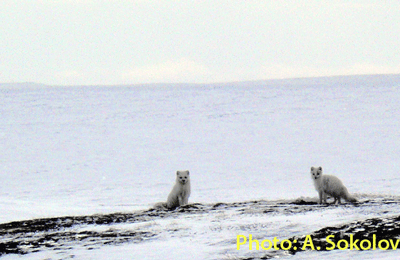 |
And I plan to travel to Erkuta for 1-2 days around the 20-25 th of May. It will be train trip. I will deliver new motor boats at Erkuta for summer field work. I think geese migration has already started around Erkuta; spring migration of geese and ducks is the great holidays for Yamal people, especially for Yamal hunters... Sincerely, Alexander |
|
RUSSIAN ACADEMY OF SCIENCE |
||

|
|
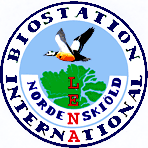 |
IPY-Arctic Predators project
Department of Biology, University of Tromsø and Norwegian Polar Institute N-9037 Tromsø, Norway
Phone: +47 77 64 62 72
© 2007
ARCTIC PREDATORS
- Website design by Nicolas Lecomte
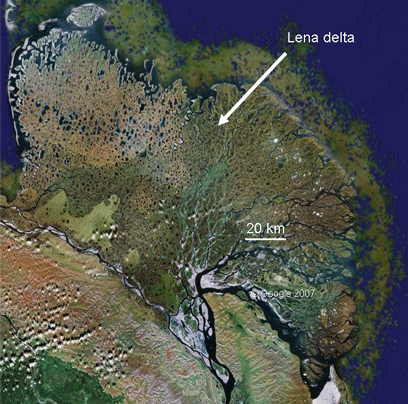
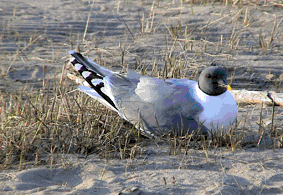
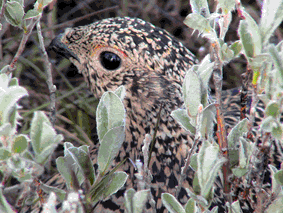
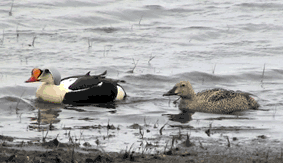
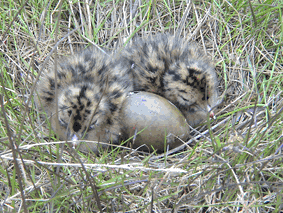
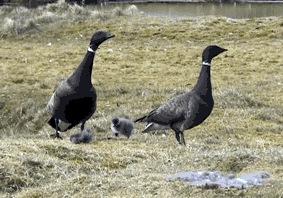
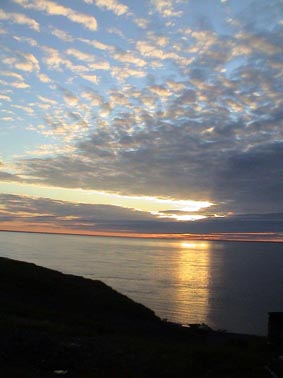
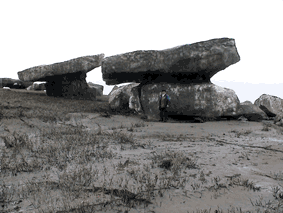 vvv
vvv